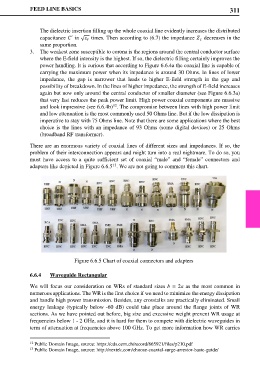Page 331 - Maxwell House
P. 331
FEED LINE BASICS 311
The dielectric insertion filling up the whole coaxial line evidently increases the distributed
capacitance in √ times. Then according to (6.7) the impedance decreases in the
′
same proportion.
3. The weakest zone susceptible to corona is the regions around the central conductor surface
where the E-field intensity is the highest. If so, the dielectric filling certainly improves the
power handling. It is curious that according to Figure 6.6.4a the coaxial line is capable of
carrying the maximum power when its impedance is around 30 Ohms. In lines of lower
impedance, the gap is narrower that leads to higher E-field strength in the gap and
possibility of breakdown. In the lines of higher impedance, the strength of E-field increases
again but now only around the central conductor of smaller diameter (see Figure 6.6.3a)
that very fast reduces the peak power limit. High power coaxial components are massive
and look impressive (see 6.6.4b) . The compromise between lines with high power limit
12
and low attenuation is the most commonly used 50 Ohms line. But if the low dissipation is
imperative to stay with 75 Ohms line. Note that there are some applications where the best
choice is the lines with an impedance of 93 Ohms (some digital devices) or 25 Ohms
(broadband RF transformer).
There are an enormous variety of coaxial lines of different sizes and impedances. If so, the
problem of their interconnection appears and might turn into a real nightmare. To do so, you
must have access to a quite sufficient set of coaxial “male” and “female” connectors and
13
adapters like depicted in Figure 6.6.5 . We are not going to comment this chart.
Figure 6.6.5 Chart of coaxial connectors and adapters
6.6.4 Waveguide Rectangular
We will focus our consideration on WRs of standard sizes b = 2a as the most common in
numerous applications. The WR is the first choice if we need to minimize the energy dissipation
and handle high power transmission. Besides, any crosstalks are practically eliminated. Small
energy leakage (typically below -60 dB) could take place around the flange joints of WR
sections. As we have pointed out before, big size and excessive weight prevent WR usage at
frequencies below 1 - 2 GHz, and it is hard for them to compete with dielectric waveguides in
term of attenuation at frequencies above 100 GHz. To get more information how WR carries
12 Public Domain Image, source: https://cds.cern.ch/record/865921/files/p210.pdf
13 Public Domain Image, source: http://nextek.com/choose-coaxial-surge-arrestor-basic-guide/

